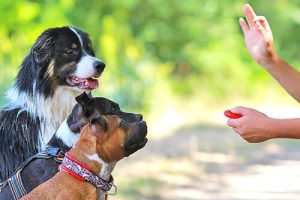Puppy training is the process of teaching a young dog basic obedience commands and social skills. It is an exciting time in a pet owner’s life as they watch their furry friend learn and grow. From potty training and crate training to teaching basic commands and preventing bad habits, puppy training is essential for a happy and healthy relationship between the puppy and the owner. In this article, we will discuss the various aspects of puppy training and provide tips on how to successfully train your pup.
Crate Training
Crate training is a popular method of house training for puppies. It involves using a crate as a safe and secure area where a puppy can rest and sleep, as well as a tool for potty training. Crate training is also useful when the owner needs to leave their puppy for short periods. In this section, we will discuss the benefits and steps to follow when crate-training your puppy.

The Benefits of Crate Training
One of the essential aspects of puppy training is crate training. Crate training provides a safe space for your furry friend to call their own, which is important for their mental and emotional well-being. The crate becomes a cozy den where they can relax and feel secure when they need downtime or a sense of refuge from their environment.
Crate training can also prevent your puppy from developing bad habits and behavior when you cannot directly supervise them. Puppies, especially at an early age, are curious and have high energy levels, which can often lead to them getting into mischief. By providing your puppy with a designated crate, you limit their access to potentially dangerous areas in your home and prevent destructive behavior.
How to Crate Train a Puppy
Crate training can be a fantastic way to teach your puppy good behavior and provide them with a safe and comfortable space to call their own. With this step-by-step guide, you can learn how to successfully crate train your furry friend using positive reinforcement techniques.
Step 1: Introduce the Crate
Begin by making the crate a positive and exciting space for your puppy. Place treats, toys, and soft blankets inside to encourage them to explore and feel comfortable in the crate. Allow your puppy to enter and exit the crate freely, without closing the door.
Step 2: Gradually Increase Time Spent in the Crate
Start by having your puppy spend a few minutes in the crate with the door closed. Stay nearby so they can hear and smell you; this will help them feel safe. Gradually increase the period your puppy spends in the crate, starting with just a few minutes and building up to a couple of hours.
Remember, never leave your puppy in the crate for an extended period. Puppies have small bladders and cannot hold their pee and poo for long.
Step 3: Use Positive Reinforcement
When your puppy is in the crate, reward good behavior with high-value treats and plenty of praise. Use a happy voice to let your puppy know they are doing a great job. Never use the crate as punishment.
Step 4: Use Potty Time and Meal Times Consistently
Regularly take breaks for potty time and meal times, using a consistent potty spot. This will help your puppy develop a routine and learn that the crate is not a place to go potty. Praise and reward your puppy when they use the correct potty spot.
Step 5: Be Patient and Consistent
Be patient and consistent with your puppy during the training process. Some puppies take longer than others to adjust to being in a crate. Keep training sessions short and positive, and gradually increase the time your puppy spends in the crate.
Potty Training
Potty training can be a challenging aspect of puppy training but it is one of the most crucial. It requires patience, consistency, and an understanding of your puppy’s behaviors. In this article, we will provide you with tips and advice on how to successfully potty train your puppy. Whether you are a first-time puppy owner or need a refresher course, this guide will help you create a plan to ensure your puppy becomes fully house-trained.
Preparing for Potty Training a Puppy
Potty training is a crucial aspect of a puppy’s development, and proper preparation and approach play a significant role in its success. As a puppy owner, it’s your responsibility to ensure that your furry friend learns to relieve themselves in appropriate places and avoid developing bad habits.
The right age to start potty training your puppy is at around eight weeks old. Before beginning the training process, ensure that you have the necessary supplies, including a crate, baby gates, high-value treats, and a designated potty spot. Routine and consistency are also vital components when it comes to potty training, so be sure to commit to a regular schedule and stick to it.
Developing a regular schedule for your puppy that includes designated potty breaks, feeding times, and playtime is crucial. Puppies have limited attention spans, so keeping a routine will help them understand what is expected of them. Consistency in feeding times will also help your pup develop a regular bowel movement schedule, making potty breaks more predictable.
There are many strategies and techniques available on how to train a puppy successfully. Crate training is one of the most effective methods, as it teaches the pup to hold its bladder and bowels until they are taken outside. Positive reinforcement training is another popular approach that focuses on rewarding the puppy for exhibiting good behavior. This can involve giving treats, praise, or offering belly rubs.
Process of Housebreaking a Puppy Using Positive Reinforcement Techniques
Housebreaking a puppy, also known as potty training, is an essential aspect of raising a happy and healthy pup. Housebreaking requires patience, consistency, and positive reinforcement training. Using positive reinforcement to train your puppy has shown to be more effective and helps build a strong bond between you and your furry friend.
The first step in housebreaking your puppy is to establish a consistent schedule for feeding, potty breaks, and playtime. This routine helps your puppy develop a sense of predictability and helps build good habits. Puppies thrive on routines. As a general rule, puppies between eight and twelve weeks old need to go outside every 30 minutes.
Take your puppy outside several times a day, especially after eating, napping, or playing. When your puppy goes outside to potty, use a verbal command like “go potty” so that they associate that word with the behavior. When the puppy goes potty outside, give them plenty of praise and offer a high-value treat to reinforce the behavior.
Basic Commands & Behavioral Issues
Training your puppy is an exciting time filled with many important milestones. While the process of house training is essential, it’s also important not to overlook the importance of teaching your puppy basic obedience commands and addressing any behavioral issues that arise. By focusing on positive reinforcement training and consistency, you can set your puppy up for long-term success and create a happy and well-behaved pup. Read on to learn more about basic commands and how to handle behavioral issues.

Teaching Basic Commands and Behaviors to Your Puppy
Teaching your puppy basic commands and behaviors is an essential part of puppy training. By using positive reinforcement training techniques and offering high-value treats as rewards, you can train your puppy to obey commands and become a well-behaved companion.
One of the first things you should do is start introducing essential commands such as “sit,” “stay,” “come,” and “heel.” It’s important to use consistent cues and positive reinforcement training techniques during training sessions. Rewards such as high-value treats like small pieces of cooked chicken, cheese, or hot dogs can help reinforce good behavior and make training more effective.
It’s essential to keep training sessions short and focused, ideally twenty to thirty minutes at a time. Focus on teaching one command at a time and repeat the command several times throughout the session. As your puppy learns, gradually increase the difficulty of the commands and the length of the training sessions.
Addressing Behavioral Problems in Young Dogs
Young dogs can display a range of behavioral issues that can be challenging for their owners to address. However, by being patient and consistent, these issues can be resolved using positive reinforcement techniques. In this article, we will outline some tips and tricks on how to address behavioral problems in young dogs.
1. Observe and Identify the Root Cause
The first step in addressing any behavioral problem in your puppy is to observe and identify the root cause of the behavior. This may take time and patience as some behaviors can be caused by a range of underlying emotions or conditions. It could be anything from separation anxiety to an easily distracted attention span.
2. Create a Plan for Addressing the Behavior
Once you have identified the root cause of the behavior, the next step is to create a plan to address the behavior through positive reinforcement training techniques. These techniques include rewarding or praising your puppy for displaying good behavior and ignoring or redirecting bad behavior.
3. Seek Professional Help
Sometimes, behavioral issues can be challenging to address on your own. In such cases, it’s important to seek the help of a professional puppy trainer who can guide you through the process. A positive reinforcement trainer can help you identify and address the root cause of the behavior and come up with a plan for training your puppy.
4. Ensure Sufficient Mental and Physical Stimulation
Another factor that can contribute to behavioral issues in young dogs is a lack of mental and physical stimulation. Young dogs have short attention spans and need regular exercise and playtime to burn off excess energy and stay mentally stimulated. Make sure your puppy has plenty of opportunities for play and exercise to avoid boredom and destructive behavior.
Conclusion
In conclusion, training a puppy requires patience, consistency, and a well-thought-out plan. By utilizing positive reinforcement training techniques and establishing a regular schedule, you can address common issues such as potty training setbacks, and ensure a successful outcome.
